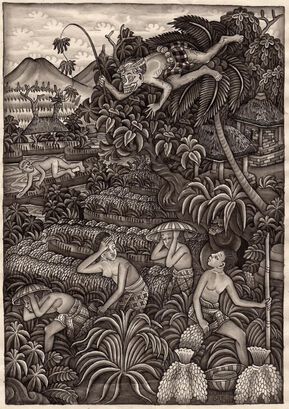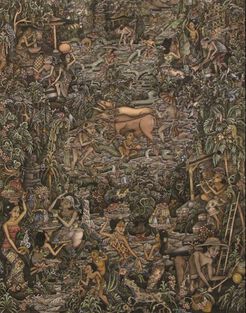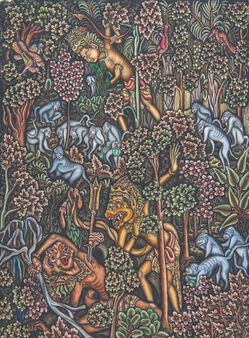Batuan Paintings
To create a new page, enter a unique page name below.
If a page with that name already exists, you will be sent to a form to edit that page.
For existing pages ... see category Batuan Paintings.
Fill in the form with the details of your image and save the page.
History Painting Art at Batuan Village
The art of painting has been known from time immemorial about hundreds of years ago, which was previously intended for the benefit of religious ceremonies in this batuan village. The painting is for ceremonial purposes such as drawing gods and placing them in temples and others. At the beginning of tourism entered the village of Ubud in the 1930s, where Tjokorde Gede Agung Sukawati invited foreign artists to visit Bali and study painting in Bali, since then batuan painting began to be glimpsed because of its very unique characteristics with the theme -theme of folklore (Tantri, Rajapala, Calonarang), wayang stories (Mahabharata and Ramayana), daily life, religious activities.
The process of working on this batuan style painting is very long and requires very high accuracy. In addition, there are also many batuan paintings that contain the values of character education and various values that can grow human awareness for the better which are absorbed from the themes of the stories of Mahabharata, Ramayana, Tantri, Calonarang, and various other folk tales that make people see them understand about the meaning of the painting he made. Along with the times, not only traditional paintings are available here, there are also various painting arts such as contemporary, abstract, minimalist and others, but the painting techniques still use batuan styles such as nyeket, ngorten, nyawi, nyigar, ngucek and manyuni, where these techniques is the hallmark of batuan style painting, so it makes the painting very different and very artistic.
Traditional Painting at Batuan Village
It is limited to ceremonial aspects such as the religious section, calendar and wayang kulit (Balinese: wayang) which is known as Kamasan or Wayang Style. Wayang itself is a two-dimensional painting that characterizes Hindu-Buddhist epics such as Mahabharata and Ramayana. The paintings were used in temples or palaces as ornaments. They describe many stories about Balinese religion and life. Usually they are pieces of a painting that tell a story. The name of the kamasan style itself is taken from the name of the village where it comes from. The materials used in the kamasan style are also traditional ingredients from minerals and vegetables or plant sources. They also use white bone, soot, or stone. Bamboo is used as a tool for painting and the media (canvas) is usually a traditional canvas made of wood, tree leaves, or cloth. In 1930, there were western artists who visited Bali and had changed the rules on Balinese painting.
The introduction of the new canvas from western materials, ink and paint, has transformed the style into modern painting. The year has started a new way of painting Balinese modern art. The increasing number of artists who come to Bali has a traditional style influence that is limited to the ceremonial aspect. Batuan village is not influenced by the west like in Ubud.
Rock paintings are often dark, overcrowded representations of legendary scenes or themes from everyday life, strange animal monsters, and witches greeting people. The paintings of Batuan Village are gradations of black to white ink that are spread over most of the surfaces, creating a pitch-dark atmosphere. In later years, the design covered the entire space, which often contributed to the bustling nature of these Balinese paintings.
More info:
Introduction to balis intricate batuan art



